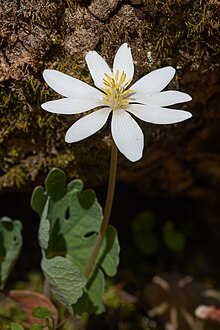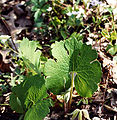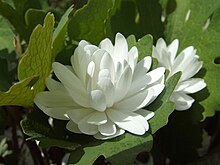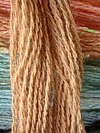Sanguinaria
| Sanguinaria | |
|---|---|

| |
| Scientific classification | |
| Kingdom: | Plantae |
| Clade: | Tracheophytes |
| Clade: | Angiosperms |
| Clade: | Eudicots |
| Order: | Ranunculales |
| Family: | Papaveraceae |
| Subfamily: | Papaveroideae |
| Tribe: | |
| Genus: | Sanguinaria L. |
| Species: | S. canadensis
|
| Binomial name | |
| Sanguinaria canadensis L.
| |
Sanguinaria canadensis, bloodroot,[1] is a perennial, herbaceous flowering plant native to eastern North America.[2] It is the only species in the genus Sanguinaria, included in the poppy family Papaveraceae, and most closely related to Eomecon of eastern Asia.
Sanguinaria canadensis is also known as Canada puccoon,[3] bloodwort, redroot, red puccoon, and black paste.[2] Plants are variable in leaf and flower shape, and have been separated as a different subspecies due to these variable shapes, indicating a highly variable species.
In bloodroot, the juice is red and poisonous.[2][4] Products made from sanguinaria extracts, such as black salve, are escharotic and can cause permanent disfiguring scarring.[2] There is no scientific evidence that it has any medicinal value for treating diseases.[2]
Description[]
This section needs additional citations for verification. (June 2021) |
Bloodroot grows from 20 to 50 cm (8 to 20 in) tall. It has one large basal leaf, up to 25 cm (10 in) across, with five to seven lobes.[5] The leaves and flowers sprout from a reddish rhizome with bright orange sap that grows at or slightly below the soil surface. The color of the sap is the reason for the genus name Sanguinaria, from Latin sanguinarius "bloody".[6] The rhizomes grow longer each year, and branch to form colonies. Plants start to bloom before the foliage unfolds in early spring. After blooming the leaves unfurl to their full size and go summer dormant in mid to late summer, later than some other spring ephemerals.
The flowers bloom from March to May depending on the region and weather. They have 8–12 delicate white petals, many yellow stamens, and two sepals below the petals, which fall off after the flowers open. Each flower stem is clasped by a leaf as it emerges from the ground. The flowers open when they are in sunlight. They are pollinated by small bees and flies. Seeds develop in green pods 4 to 6 cm (1+1⁄2 to 2+1⁄4 in) long, and ripen before the foliage goes dormant. The seeds are round and black to orange-red when ripe, and have white elaiosomes, which are eaten by ants.
- Stages in the life of bloodroot

Leaves clasping the flower stems in early spring
White petals and yellow stamens

Fruit (a pod holding the seeds) in early summer

Leaves after flowering

A carpet of leaves in late spring
Rhizomes with orange flesh
Distribution and habitat[]
Bloodroot is native to eastern North America from Nova Scotia to Florida, and west to the Great Lakes and down the Mississippi embayment.
Sanguinaria canadensis plants are found growing in moist to dry woods and thickets, often on floodplains and near shores or streams on slopes. They grow less frequently in clearings and meadows or on dunes, and are rarely found in disturbed sites. Deer feed on the plants in early spring.
Ecology[]
Bloodroot is one of many plants whose seeds are spread by ants, a process called myrmecochory. The seeds have a fleshy organ called an elaiosome that attracts ants. The ants take the seeds to their nest, where they eat the elaiosomes, and put the seeds in their nest debris, where they are protected until they germinate. They also benefit from growing in a medium made richer by the ant nest debris.
The flowers produce pollen, but no nectar. Various bees and flies visit the flowers looking in vain for nectar, for instance sweat bees in the genera Lasioglossum and Halictus, cuckoo bees in the genus Nomada, small carpenter bees (Ceratina), and bee flies in the genus Bombylius. Some bees come to collect pollen, including mining bees (Andrena), which are the most effective pollinators.[7][8]
The bitter and toxic leaves and rhizomes are not often eaten by mammalian herbivores.[8]
Cultivation[]

Sanguinaria canadensis is cultivated as an ornamental plant. The double-flowered forms are prized by gardeners for their large showy white flowers, which are produced very early in the gardening season. Bloodroot flower petals are shed within a day or two of pollination, so the flower display is short-lived, but the double forms bloom much longer than the normal forms. The double flowers are made up of stamens that have been changed into petal-like parts, making pollination more difficult.[citation needed]
The double-flowered cultivar S. canadensis f. multiplex 'Plena' has gained the Royal Horticultural Society's Award of Garden Merit.[9][10]
Phytochemicals[]
Sanguinaria root contains rich amounts of isoquinoline alkaloids, mainly sanguinarine and chelerythrine.[2] Bright red in water components of the plant, sanguinarine derives from rhizomes and roots, with lesser amounts found in leaves and flowers.[2] Related compounds in the plant are berberine and protopine, among other minor alkaloids.[2]
Toxicity[]
Bloodroot produces benzylisoquinoline alkaloids, primarily the toxin sanguinarine. The alkaloids are transported to and stored in the rhizome.
Sanguinarine kills animal cells by blocking the action of Na+/K+-ATPase transmembrane proteins. As a result, applying bloodroot to the skin may destroy tissue and lead to the formation of necrotic tissue, called an eschar. Bloodroot and its extracts are thus considered escharotic. Although applying escharotic agents (including bloodroot) to the skin is sometimes suggested as a home treatment for skin cancer, these attempts can be severely disfiguring.[11] Salves, most notably black salve, derived from bloodroot do not remove tumors. Microscopic tumor deposits may remain after visible tumor tissue is burned away, and case reports have shown that in such instances tumor has recurred and/or metastasized.[12]
Internal use is not recommended.[13] An overdose of bloodroot extract can cause vomiting and loss of consciousness.[13]
Alkaloid biosynthesis[]
Comparing the biosynthesis of morphine and sanguinarine, the final intermediate in common is (S)-reticuline.[14][15] A number of plants in Papaveraceae and Ranunculaceae, as well as plants in the genus Colchicum (family Colchicaceae) and genus (family Menispermaceae), also produce such benzylisoquinoline alkaloids. Plant geneticists have identified and sequenced genes which produce the enzymes required for this production. One enzyme involved is N-methylcoclaurine 3'-monooxygenase,[16] which produces (S)-3'-hydroxy-N-methylcoclaurine and mendococlaurine from (S)-N-methylcoclaurine.
Uses[]
Traditional medicine[]
Bloodroot was used historically by Native Americans for curative properties as an emetic, respiratory aid, and other treatments.[2][17]
Bloodroot extracts have also been promoted by some dietary supplement companies as a treatment or cure for cancer,[2] but the U.S. Food and Drug Administration has listed some of these products among its "187 Fake Cancer 'Cures' Consumers Should Avoid".[18] Oral use of products containing bloodroot are strongly associated with the development of oral leukoplakia,[19] which is a premalignant lesion that may develop into oral cancer, although one review disputed this finding.[20] Dental products containing bloodroot were withdrawn from the United States market in 2016 due to concerns about their potential to cause cancer.[2]
This plant has also been used in medical quackery, as was evidenced by the special product produced by Dr. John Henry Pinkard during the 1920s and 1930s. Some bottles of "Pinkard's Sanguinaria Compound", made from bloodroot or bloodwort, were seized by federal officials in 1931. "Analysis by this department of a sample of the article showed that it consisted essentially of extracts of plant drugs including sanguinaria, sugar, alcohol, and water. It was alleged in the information that the article was misbranded in that certain statements, designs, and devices regarding the therapeutic and curative effects of the article, appearing on the bottle label, falsely and fraudulently represented that it would be effective as a treatment, remedy, and cure for pneumonia, coughs, weak lungs, asthma, kidney, liver, bladder, or any stomach troubles, and effective as a great blood and nerve tonic." John Henry Pinkard plead guilty and was fined $25.00.[21]
Commercial uses[]
Commercial uses of sanguinarine and bloodroot extract include dental hygiene products.[2] Some animal food additives sold and distributed in Europe contain sanguinarine and chelerythrine.[2]
Plant dye[]
Bloodroot is a red natural dye used by Native American artists, especially among southeastern rivercane basketmakers.[22] A break in the surface of the plant, especially the roots, reveals a reddish sap which can be used as a dye.[2]
See also[]
References[]
- ^ "Sanguinaria canadensis". Germplasm Resources Information Network (GRIN). Agricultural Research Service (ARS), United States Department of Agriculture (USDA). Retrieved 12 December 2017.
- ^ Jump up to: a b c d e f g h i j k l m n "Bloodroot". Drugs.com. 22 March 2021. Retrieved 1 June 2021.
- ^ "RHS Plantfinder - Sanguinaria canadensis". Retrieved 28 October 2018.
- ^ "Bloodroot Wildflowers". Wild Flowers Guide. Archived from the original on 2014-08-21.
- ^ Kiger, Robert W. (1997). "Sanguinaria canadensis". In Flora of North America Editorial Committee (ed.). Flora of North America North of Mexico (FNA). 3. New York and Oxford – via eFloras.org, Missouri Botanical Garden, St. Louis, MO & Harvard University Herbaria, Cambridge, MA.
- ^ Kiger, Robert W. (1997). "Sanguinaria". In Flora of North America Editorial Committee (ed.). Flora of North America North of Mexico (FNA). 3. New York and Oxford – via eFloras.org, Missouri Botanical Garden, St. Louis, MO & Harvard University Herbaria, Cambridge, MA.
- ^ Heather Holm (2014). Pollinators on Native Plants. Minnetonka, MN: Pollinator Press. pp. 164–165.
- ^ Jump up to: a b Hilty, John (2016). "Bloodroot (Sanguinaria canadensis)". Illinois Wildflowers.
- ^ "RHS Plant Selector – Sanguinaria canadensis f. multiplex 'Plena'". Retrieved 23 February 2020.
- ^ "AGM Plants - Ornamental" (PDF). Royal Horticultural Society. July 2017. p. 94. Retrieved 28 October 2018.
- ^ Don't Use Corrosive Cancer Salves (Escharotics), Stephen Barrett, M.D.
- ^ McDaniel, S.; Goldman, GD (2002). "Consequences of Using Escharotic Agents as Primary Treatment for Nonmelanoma Skin Cancer". Archives of Dermatology. 138 (12): 1593–6. doi:10.1001/archderm.138.12.1593. PMID 12472348.
- ^ Jump up to: a b "Bloodroot (Sanguinaria canadensis L.)". Horticulture Information Leaflets. NC State Extension Publications.
- ^ Alcantara, Joenel; Bird, David A.; Franceschi, Vincent R.; Facchini, Peter J. (2005). "Sanguinarine Biosynthesis is Associated with the Endoplasmic Reticulum in Cultured Opium Poppy Cells after Elicitor Treatment". Plant Physiology. 138 (1): 173–83. doi:10.1104/pp.105.059287. JSTOR 4629815. PMC 1104173. PMID 15849302.
- ^ "PATHWAY: Alkaloid biosynthesis I – Reference pathway". Kyoto Encyclopedia of Genes and Genomes (KEGG).
- ^ "ENZYME: 1.14.13.71". Kyoto Encyclopedia of Genes and Genomes (KEGG).
- ^ Native American Ethnobotany (University of Michigan – Dearborn: Sanguinaria canadensis . accessed 12.1.2011
- ^ "187 Fake Cancer "Cures" Consumers Should Avoid". United States Food and Drug Administration. Archived from the original on 2009-07-10. Retrieved 2019-08-18.
- ^ Bouquot, Brad W. Neville , Douglas D. Damm, Carl M. Allen, Jerry E. (2002). Oral & maxillofacial pathology (2. ed.). Philadelphia: W.B. Saunders. p. 338. ISBN 0721690033.
- ^ Ic, Munro; Es, Delzell; Er, Nestmann; Bs, Lynch (30 December 1999). "Viadent Usage and Oral Leukoplakia: A Spurious Association". Regulatory Toxicology and Pharmacology. 30 (3): 182–96. doi:10.1006/rtph.1999.1339. PMID 10620468.
- ^ Case #19890. Misbranding of Pinkard's sanguinaria compound. U. S. v. John Henry Pinkard. Plea of guilty. Fine, $25.
- ^ Nolan, Justin. "Northeast Oklahoma, USA." Society of Ethnobotany. 2007 (retrieved 9 Jan 2011)
External links[]
| Wikimedia Commons has media related to Sanguinaria. |
- Flora of North America: Distribution map
- Connecticut Plants, Connecticut Botanical Society
- NatureServe secure species
- Papaveroideae
- Monotypic Papaveraceae genera
- Flora of Eastern Canada
- Plant dyes
- Garden plants of North America
- Plants used in traditional Native American medicine
- Abortifacients








